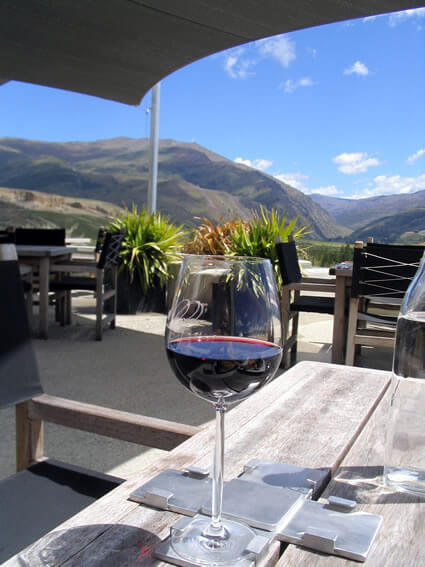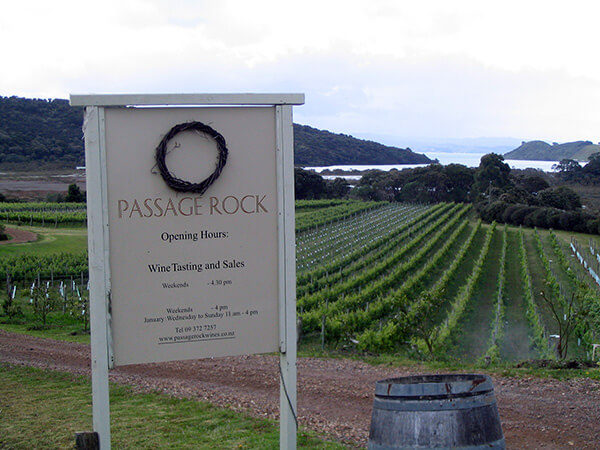Cycling and Learning about Wines in New Zealand
Article and photos by Michael Kerwin

|
|
Enjoy a fine glass of red in New Zealand with a view.
|
New Zealand offers several opportunities to cyclists and wine enthusiasts. First, its summer months — December, January, and February — correspond to the winter months in the northern hemisphere. Second, at least two places — Central Otago and Waiheke Island — promote bicycle tourism. Third, these areas are known for red wines and spectacular scenery. Cycling in Central Otago and on Waiheke Island is not for everyone. The rides can be challenging, and cyclists must be well prepared.
Central Otago Island
Central Otago is rocky, wild, and desolate. Landlocked within the southern one-third of New Zealand’s South Island, the region covers 10,000 square kilometers and has fewer than 16,000 residents. Mountains rise to 6,500 feet, and the Clutha, Manuherika, and Taieri Rivers form gorges and valleys. Semi-arid, the region annually records New Zealand’s coldest and hottest temperatures. Many miners who came there in the 1860s to seek their fortunes in the goldfields were unprepared for the winter and froze to death. Until the first section of the Otago Central Railway was built in 1891, the area was relatively inaccessible; the line was completed in 1921. The Lord of the Rings introduced many Americans to the area. Known as Middle Earth in the film, much of The Two Towers was shot there.
The Central Otago Rail Trail, opened in 2000, follows the route of the old Otago Central Railway Line from Middlemarch to Clyde, a distance of 150 kilometers. The gravel track is restricted to walkers, cyclists, and horse riders. Cycle Surgery, with shops at both ends of the trail, rents 21-speed, pannier-equipped mountain bikes and ships luggage from one shop to another. It is perfect for the cycling oenophile. However, the traveler must be warned that accommodations are few and far apart.
From Middlemarch to Alexandra, I cycled through valleys between tall mountain ridges, traversed three tunnels, and crossed 19 bridges and viaducts, one of which was among the tallest in New Zealand. Sheep were often pastured on both sides of the trail, and snow-capped mountain peaks were always in view. The land was steep, rocky, and covered with wild thyme. Had I not seen the vines, I would not have imagined that grapes could be grown there.
A winemaker I met at a motel bar in Alexandra told me to visit Black Ridge, which exemplified those I visited in Central Otago. Verdun Burgess, one of the owners and a pioneer in Central Otago winemaking, told me that he had used gelignite to blast holes for his vine posts, but that wasn't his only problem. Thousands of rabbits had overrun his vineyard and killed the vines by eating the leaves of new plants or ring-barking established plants. Burgess's eventual solution was to employ Burmese cats, which would dispatch as many as 300 rabbits yearly. His Pinot Noir, like the best from the region, encapsulated big fruit flavors and amalgamated them with subtle hints of thyme. It was perfect with charcuterie and cheese.
Although I cycled from Alexandra to Cromwell and visited several vineyards in that area before returning my bike, collecting my luggage, and boarding a bus to Queenstown, I would only recommend that route to some. State Highway 8 traverses the barren and windswept Cromwell Gorge, and cycling can be challenging. Fortunately, I enjoyed a tailwind, but when I arrived in Cromwell and turned into the wind, it stopped me in my tracks!
November, December, March, and April are the best times to cycle in Central Otago. Strong north winds are less likely to occur, and rain is not as prevalent. The Taieri Gorge Railway provides train service from Dunedin to Middlemarch.
Waiheke Island

|
|
The vineyards on Waiheke Island, New Zealand, produce tastes of the land.
|
Waiheke Island, located about 1000 kilometers closer to the equator than Central Otago, is the largest of 40 islands in the Hauraki Gulf, east of Auckland. The northern coasts contain rocky headlands formed by volcanic eruptions 14 million years ago. In contrast, the southern coasts have mudflats, shell banks, and mangroves. Most of Waiheke's 13,000 inhabitants live in villages on the island's western end; the eastern half is remote and pastoral, resembling the Scottish highlands.
Waiheke Island is also known for its cabernet sauvignon. At least 26 vineyards had been established on the island, containing around 300,000 vines. An island map at the
Waiheke Island is also on the Waiheke Island tourism site, outlines three bicycle loops, each passing different vineyards. Bike Hire, a short walk from the wharf, rents mountain bikes. It is another match for the cycling oenophile.
I cycled there for three days and sampled wine at four vineyards. My favorites were Passage Rock and Te Whau. Both provided scenic vistas of the Hauraki Gulf. On the Waiheke Island map, Passage Rock was located on the Bottom End Loop. The map, however, did not indicate the island's topography. Before I reached Passage Rock, I ascended at least four significant hills. Even though I arrived at the vineyard's restaurant an hour before it opened, I stayed there. My legs needed the rest, and I doubted my body could take on another hill without refueling. When it did open, I sampled five wines; the 2005 Syrah was the star. It was deep purple and tasted of blackberries. Following the tasting, I devoured a smoked meat pizza baked in a wood-fired oven. At Te Whau, I drank a blend of merlot and cabernet grapes grown on the point of land where the vineyard was located, which was luscious.
I concluded my cycling and wine sampling trip to New Zealand with a celebratory meal at the Palm Beach Clubhouse, a popular spot for local winemakers near Little Palm Beach, Auckland's most famous nude bathing beach. My dinner began with Lindauer Special Reserve Champagne and Te Matuku oysters. It continued with lamb rump, with deep-fried Komaru strips and caramelized onions. I drank Passage Rock Sisters, a red blend, with the main course and sat at the bar because a group of wine producers had booked all of the restaurant's tables. When one of them came to the bar and saw what I was eating and drinking, he gave me the thumbs-up sign. I felt assigned a test on selecting New Zealand wines and pairing them with food.
Because Waiheke Island is a popular weekend and vacation destination for Aucklanders, booking accommodations ahead is essential. Shuttles take travelers from the Auckland airport to the ferry terminal, and ferries make frequent trips between Auckland and Waiheke Island.
The Tastes of the Wines from the Islands
Central Otago and Waiheke Island provide contrasting experiences for the cycling oenophile and bring into focus the effect of terroir, the French term meaning total elements of the vineyard, on a wine's color, aroma, and taste. Central Otago's Pinot Noirs are as dramatic as its landscape: blackish garnet in color with whiffs of licorice and raspberry and flavors of black cherry with herbal undertones. Waiheke's Island's red wines are more Mediterranean: ruby and deep purple with aromas and flavors of black fruits. After cycling through the two landscapes, the traveler remembers the wines.
Michael Kerwin is a professional tour guide, teacher, writer, and oenophile. His stories have appeared in Bicycle USA, Bluegrass Tomorrow, Keeneland Magazine, and The Chevy Chaser Magazine.
|
